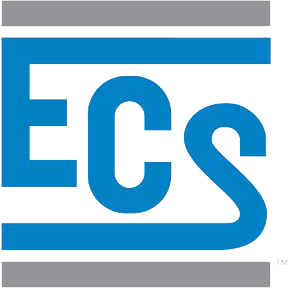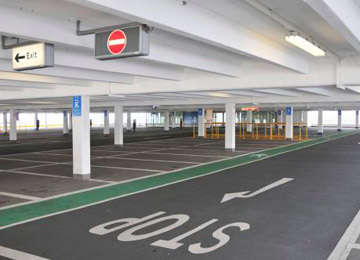In climates where road de-icing salts are used, concrete parking garage slab deterioration can be a significant maintenance cost. Deterioration occurs in garages as vehicles carry in snow and ice that has been treated with de-icing salts. Slab deterioration is a cyclical problem that can start out small and become significant with time. Slab deterioration is typically related to concrete cracking, which allows water to reach and corrode the slab reinforcing steel. Reinforcement corrosion is greatly accelerated when de-icing salts are used.
One cause of concrete cracking is shrinkage as the concrete cures. These surficial cracks allow moisture to reach the reinforcing steel. When the steel corrodes, its effective volume increases, as iron oxide takes up approximately three times the volume of uncorroded steel. This exerts tensile forces in the surrounding concrete, resulting in a horizontal crack (typically along, or just above, the plane of the reinforcing steel). This separates the top of the slab from the bottom. This horizontal cracking – called “delamination” – is not visible. However, spalling and excessive concrete surface cracking can be evidence of delamination. When surficial and delamination cracks combine, the resulting network provides pathways for moisture to reach and corrode reinforcing steel. Freezing water expands the cracks, creating more tensile force, leading to more cracking and delamination.
Another factor that contributes to slab deterioration is if concrete contains elevated levels of chloride ions. Prior to the mid-1980s, calcium chloride admixtures were used during winter construction to accelerate concrete curing. The American Concrete Institute (ACI) and the Post Tensioning Institute (PTI) no longer allow chloride-containing admixtures. Chloride ion levels can be determined by sampling the concrete. A drill is used to pulverize the concrete into dust, which is collected from different below surface depths. The chloride content at the reinforcement level is most important. ACI has established a maximum water-soluble chloride ion content of 0.06% by weight of cement in prestressed concrete to limit reinforcing steel corrosion.
A common technique to detect delaminated areas is chain dragging. As the name implies, a chain is dragged over the surface of the slab. When the chain passes over a delaminated area, it produces a distinct hollow sound. Delamination areas are marked with spray paint. While not sophisticated, it is an effective and economical technique. If reinforcement corrosion is a concern, corrosion mapping can be performed. Half-cell potential measurements can help evaluate corrosion activity on the slab reinforcing steel. Using this technique, probable corrosion areas in the slab can be identified for evaluation and potential replacement.
Repairs involve chipping out the damaged sections and replacing them with new concrete. Deterioration will continue in areas that are not repaired. Once reinforcing steel is exposed during the repair process, it is common to find that cracking extends beyond the limits initially identified during the delamination study.
For new parking garage designs, reduced permeability concrete mixes, epoxy- or zinc-coated reinforcing steel, corrosion inhibiting concrete admixtures, surface-penetrating sealants, and surficial coatings can be used to reduce deterioration and the associated maintenance costs. The higher initial cost can be evaluated against the potential maintenance costs over the life of the parking garage.
A good maintenance practice is to wash down the garage slabs at least once a year, preferably in the spring after the use of de-icing salts has ceased for the season. Cracks and joints should be sealed to reduce water migration; joint sealants should be checked for deterioration and replaced as necessary. Penetrating sealants and surficial coatings can be applied to reduce the potential for delamination cracking. A seven-year recurring schedule is typical, with an approximate annual maintenance and repair budget of $0.10 to $0.30 per square foot or $30.00 to $90.00 per parking space.

